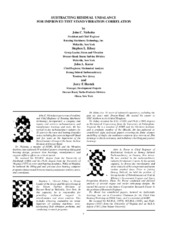| dc.description.abstract | The importance of correlating rotordynamic analytical results to actual test data has become extremely important in recent years. Many user specifications require the verification of vendor generated analytical results in conjunction with shop unbalance testing. This correlation generally includes critical speed, amplification factor, and vibration magnitude. Several problems arise during shop unbalance testing. First, it is not always feasible to place an unbalance test weight in a location where it will logically excite the mode in question. This can lead to test runs where, despite a large unbalance weight, the residual unbalance is more influential than the test weight. Thus, the resulting rotor vibration is controlled by the residual unbalance and not the test unbalance. Consequently, any type of analytical correlation for this situation is extremely difficult. Another problem with test stand data is that it usually comes from four different vibration probe locations. This results in four vibration plots and, in many cases, four different critical speeds, amplification factors, and vibration magnitudes. Again, the analytical correlation for this situation is extremely difficult, since determining the actual values for these parameters is somewhat nebulous. These problems are addressed herein and a solution is offered. Several examples of analytical and test stand results are presented for steam turbines and centrifugal compressors. These examples highlight and discuss the problem areas identified. A method is presented for subtracting the vibration due to residual unbalance from that of the verification test. The resulting vibration with residual subtraction isolates the effect of the unbalance weight, and leads to improved correlation with analytical prediction | en |


